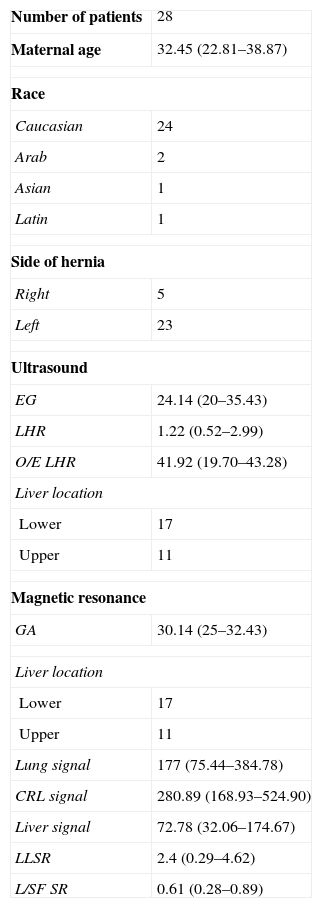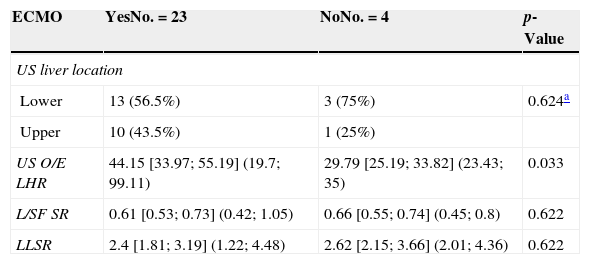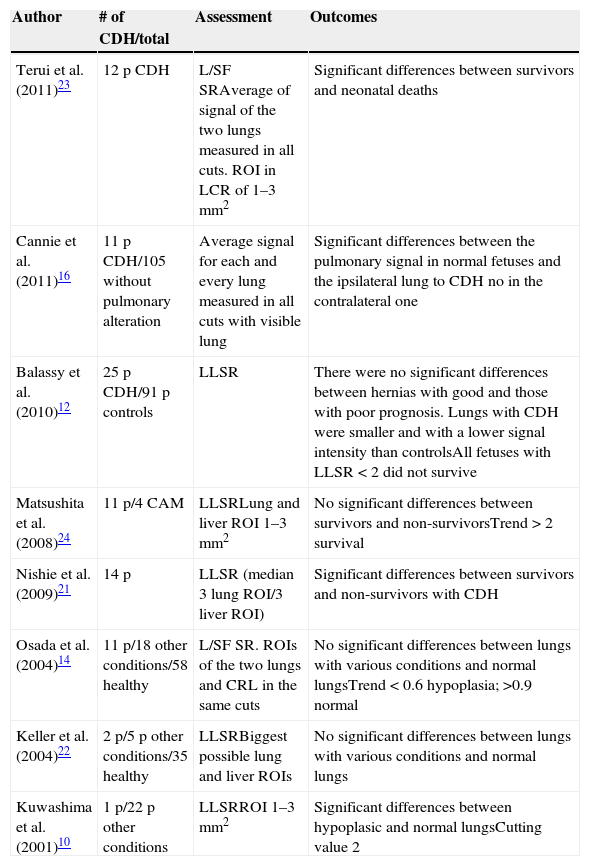To determine the usefulness of various parameters based on T2-weighted fetal magnetic resonance (MR) imaging measurements of the uninvolved lung for the neonatal prognosis of congenital diaphragmatic hernia (CDH).
Materials and methodsWe used ultrasonography and MR imaging to study 28 fetuses with CDH. We retrospectively analyzed (a) on fetal ultrasonography, the observed-to-expected lung to head ratio (O/E LHR) and the position of the liver, and (b) on fetal MR imaging, the lung-liver signal ratio (LLSR) and the lungcerebrospinal fluid ratio (L/CSF SR). To determine the prognostic value of these parameters, we compared them with the following postnatal parameters: survival, pulmonary hypertension, need for oxygen supplementation, and need for extracorporeal membrane oxygenation.
ResultsWe found significant differences between O/E LHR and the need for postnatal extracorporeal membrane oxygenation (p=.033) and postnatal survival (p=.01). We also found significant differences in LLSR between fetuses that survived more than 45 days and those that died within 45 days (1.91 vs 2.56; p=.039).
ConclusionsIn fetuses with CDH, the LLSR correlates with postnatal survival and can potentially be used as a prognostic parameter in CDH.
Determinar el pronóstico neonatal de la hernia diafragmática congénita (HDC) partiendo de la señal relativa del pulmón contralateral en secuencias rápidas T2 de resonancia magnética (RM) fetal.
Material y métodosEstudiamos mediante ecografía y RM 28 fetos afectos de HDC y valoramos retrospectivamente en la ecografía fetal la relación entre el cociente observado y el esperado del diámetro axial máximo del pulmón dividido por el perímetro craneal (O/E LHR) y la posición hepática, y en la RM fetal el cociente de señal pulmón/hígado (LLSR) y el cociente de señal pulmón/líquido cefalorraquídeo (L/SF SR). Para determinar su valor pronóstico, los comparamos con los parámetros posnatales: supervivencia, hipertensión pulmonar, necesidad de oxígeno y la necesidad de oxigenación con membrana extracorpórea.
ResultadosEncontramos diferencias significativas entre O/E LHR y la necesidad de oxigenación con membrana extracorpórea posnatal (p=0,033) y la supervivencia posnatal (p=0,01), y entre el LLSR de los fetos que sobrevivieron más de 45 días y los que no, con unas medianas de 1,91 y 2,56 respectivamente (p=0,039).
ConclusionesEl LLSR se correlaciona con la supervivencia posnatal en fetos con HDC y puede potencialmente utilizarse como parámetro pronóstico de la HDC fetal.
Artículo
Comprando el artículo el PDF del mismo podrá ser descargado
Precio 19,34 €
Comprar ahora














